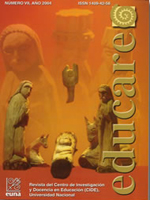Integración del aspecto cultural en la clase de inglés
DOI:
https://doi.org/10.15359/ree.2004-7.12Abstract
Since culture and language are closely related, culture cannot be left aside when teaching languages. Cultural training is mush more than being exposed to cultural information; includes the critical evaluation of such information and comparison whit one's culture. In today's globalized world, cultural competence has become fundamental. The following article introduces a unit to incorporate culture into the English class as a foreign language in Costa Rica. It suggests activities to develop intercultural awareness and linguistic objectives.
References
Crawford-Lange, L. y Lange, D. (1984). Doing the Unthinkable in the Second Language Classroom. ACTFL Foreing Language Education Series. 15.
Fiber Luce, L. y Smith, E. eds. (1994). Toward Intemationalism: Readings in Cross Cultural Communication. Nueva York Newbury House Publishers.
Gudykunst, W. B. y Ting Tooney, S. (1988). Culture and Interpersonal
Communication. London: Sage Publishers.
Hall, E. T. 1976. Beyond Culture. Nueva York: Anchor Books.
Kim, Y. K. (1984). Communication and Acculturation Communicating
lnterculturally.
Martín, J. M. (2000). La interculturalidad: aspectos de su aprendizaje y
educación desde la perspectiva de la interacción comunicativa. http://www.ub.es/filhis/culturele/morillas.html.
Ruben, B. et al. (1977). Cross Cultural Effectiveness. Intercultural
Communication: State of the Art. Pittsburg: SIETAR.
Seelye, N., ed. (1966). Experimential Activities for Intercultural Learning. Yarmouth, Maine: Intercultural Press.
Trudgill, P. (1983). Sociolinguistics: An Introduction to Language and
Society. Middleses: Penguin Books.
Widdowson, H. (1988). Aspects of the relationship between culture and
Language. Culture and Language.
Downloads
Published
How to Cite
Issue
Section
License
1. In case the submitted paper is accepted for publication, the author(s) FREELY, COSTLESS, EXCLUSIVELY AND FOR AN INDEFINITE TERM transfer copyrights and patrimonial rights to Universidad Nacional (UNA, Costa Rica). For more details check the Originality Statement and Copyright Transfer Agreement
2. REUTILIZATION RIGHTS: UNA authorizes authors to use, for any purpose (among them selfarchiving or autoarchiving) and to publish in the Internet in any electronic site, the paper´'s final version, both approved and published (post print), as long as it is done with a non commercial purpose, does not generate derivates without previous consentment and recognizes both publisher's name and authorship.
3. The submission and possible publication of the paper in the Educare Electronic Journal is ruled by the Journal’s editorial policies, the institutional rules of Universidad Nacional and the laws of the Republic of Costa Rica. Additionally, any possible difference of opinion or future dispute shall be settled in accordance with the mechanisms of Alternative Dispute Resolution and the Costa Rican Jurisdiction.
4. In all cases, it is understood that the opinions issued are those of the authors and do not necessarily reflect the position and opinion of Educare, CIDE or Universidad Nacional, Costa Rica. It is also understood that, in the exercise of academic freedom, the authors have carried out a rogorous scientific-academic process of research, reflection and argumentation thar lays within the thematic scope of interest of the Journal.
5. The papers published by Educare Electronic Journal use a Creative Commons License:














 The articles published by Educare Electronic Journal can be shared with a Creative Commons License:
The articles published by Educare Electronic Journal can be shared with a Creative Commons License: 



